As much as images of violence, civil war, and sectarian strife become prominent in the media narrative of the Syrian uprising, little gems of innovative cultural production, artistic resistance, and creative disobedience continue to sprout across the virtual alleys of the Internet. These creative gems are also the germs of a viral peer-production process at work at a grassroots level in the new Syrian public sphere. Such acts of creativity—mash-ups, cartoons, slogans, jokes, songs, and web series---are probably too small and inconsistent in impact compared to the horrific magnificence that shelling, bombing, sniping, and killing scenes that provide daily fodder to global television viewers. It is also challenging to discover them; in fact, as remarked by Tunisian blogger Sami ben Gharbia at the Arab Bloggers meeting in Tunis (3-6 October 2011), Facebook is not the most suitable platform for activists to store, archive, tag, search for content, and give it a context.
Facebook`s chaotic flow of people’s relationships enmeshed with information and updates probably matches the mess and instability of Syrians’ daily life, but clashes with standard media routines made up of practices like tracking original sources, archiving, and planning schedules. From time to time, these daily exercises of creativity manage to find their way out of the Internet overflow and get noticed, analyzed, and framed in a broader discussion, usually centered on art and dissent in a time of unrest.
Since the beginning of the uprising in March 2011, my attention was caught by one of these creative works, namely an advertising poster. The poster started as a regime-backed advertising campaign and then took the unexpected shape of viral peer-produced work, still being shared and re-manipulated by users more than a year after its creation. The outdoor campaign, which started just a few weeks after the first demonstration hit the center of Damascus on 15 March, was clearly aimed at restoring order in the streets and discouraging people from participating in further protests. Billboards featured a raised hand declaring: “whether progressive or conservative, I am with the law,” “whether girl or boy, I am with the law,” and other similar slogans, all matched with multi-colored, raised hands. At some point, with all these colored hands raised everywhere in public spaces, cities had a sort of Orwellian atmosphere, a sort of “Big Brother” watching citizens and reminding them to comply with the law.
Soon thereafter, parodies of these posters started mushrooming in cyberspace. Depicting the very same raised colored hand, each virtual poster carried a different slogan. “I am free,” said one raised hand on a Facebook group.
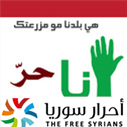
["I am Free" Uncredited Image from Facebook]
“I lost my shoes” echoed another---suggesting that the shoes had been thrown at the dictator, a way to express scorn and dissent in the Arab world. “I am not Indian,” joked another poster, meaning “I am not stupid”, “you cannot fool me.” By answering “I am not Indian” to the “I am with the law” poster, citizens were using a colloquial, ironic – and rather racist—saying to re-affirm their “Syrianness.” Syrians didn`t want to be fooled as if they were foreigners in their own country; being very much aware that the regime had exclusive control over the formal meaning of “law” and “lawlessness.”
.jpg)
["I am not Indian" Uncredited Image from Facebook]
At some point, probably after realizing the problematic nature of the word “law” —and the ambiguous relationship between ruler and ruled that it entailed in the country – the campaign was re-designed to reflect a more neutral, sober form.
This time, the raised hand simply said: “I am with Syria.” The colors used were those of the Syrian national flag—red, white, black, and green—and the slogan declared: “my demands are your demands.” It was probably safer to try to win citizens’ hearts and minds by appealing to a middle-way, a generic form of “nationalism,” as if all the Syrian people’s demands would have to be exactly the same.
In a way, the “I am with the law” raised hands campaign’s switch to a generic “I am with Syria” slogan could have been a direct response to the “I am not Indian” poster which invited the advertiser —and the ruler — to re-frame the issue in the direction of a shared “Syrian” common ground. Yet the new, more accommodating campaign registered another novel wave of user-generated responses over the Internet, and beyond the virtual spaces. Armed with a marker (and probably at nighttime), some citizens took the courage to descend from the virtual alleys of Facebook to the real streets of Syria. They deleted the second half of the slogan—“my demands are your demands”—and changed it into: “my demands are freedom.”
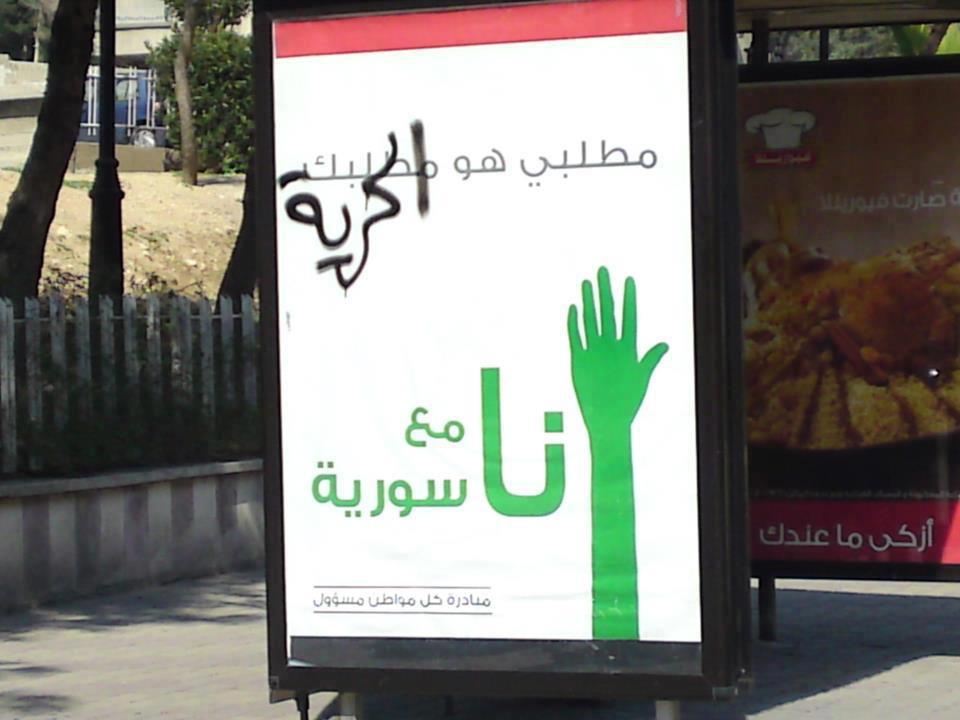
[Modified billboard reads "My Demand is Freedom." Uncredited image from Facebook]
When I present this witty example of Syrian user-generated creativity at conferences or public talks, I usually get two different types of comments. The first praises this category of creative acts as the tangible signal that the “wall of fear” has been broken and that Syrians are now able to express their opinions freely, hitting back at the regime with multi-sided messages of their own. The second type of comments, beyond admiring the creativity behind this user-generated counter-campaign, dismiss it as too small and insignificant to challenge the regime at a political level. This type of criticism also deems user-generated creativity irrelevant to counterbalance industrially-produced forms of arts and culture, like television fiction (the well-known musalsalat), whose regime-tolerated content and messages reach a much wider audience than any viral campaign online. Here both comments are focused on the content of user generated creativity, whether in its political or artistic dimension. However, by doing that, they miss its context, i.e. the environment where this creativity is generated and the relations it entails.
Instead, I argue we should rather analyze the context of the Syrian user-generated creativity in order to understand what this implies and reveals, on both political and artistic dimensions, i.e. the existence of a pro-active citizenship movement comprised of peer-creators who are able to manipulate regime-backed messages and re-inject them into public space.
In this perspective, Syrian user-generated creativity is a victim of what American scholar and Internet expert Clay Shirky (2010) calls “the milkshake mistake.” Shirky refers to an American researcher who, when asked to study consumers’ habits vis-a-vis milkshakes, decided to focus exclusively on the social behaviors of the purchasers rather than on the product itself. Focusing on the context of the purchase rather than on the object purchased, he noticed that the majority of the milkshake buyers had bought the product in the early morning to take it away during their long commute to workplaces. What inspires Shirky in this story is that products do not exist in isolation but are enmeshed in cultural and social environments where purchasers “hire” them to perform certain “jobs.”
Like Shirky’s milkshakes, the Syrian user-generated counter-advertising campaign should be understood for the “job” it does on behalf of Syrian citizens. By analyzing the user-generated raised-hands counter-campaign as purely a piece of content, the result would be to dismiss it as something trivial or irrelevant, both in the political and in the artistic sense, as they would not be able to compete with any spectacular contentious action—such as a demonstration—or with industrially-led media production—as musalsalat. Instead, we should perhaps focus on the context that has generated it, following Shirky`s remark that even “the stupidest possible creative act is still a creative act;” and asking ourselves why and to what purpose this “stupid” yet creative act is still useful.
Japanese entrepreneur and Director of MIT Media Lab, Joichi Ito, speaks of the Internet as a context-oriented environment where people and information are interconnected. This interconnection generates memes, i.e. units for carrying cultural ideas, symbols or practices that spreads virally from person to person. Memes are like ongoing open-ended conversations. They replicate information and produce copies of themselves; yet not exact copies, as in the user-generated raised hands of the Syrian counter-advertising campaign.
Cognitive systems’ expert and scholar Francis Heylighen identifies in “collective utility” one of the main criteria that makes the meme travel from one individual to another and get to be re-used: “the meme is useful for the group, without necessarily being useful for the individual.” Joichi Ito reinforces this idea by stating that “it is the use, familiarity and reproduction that makes a meme powerful and proves its aesthetic quality.” Going back to the context of Syrian user-generated creativity, how can the reproduction, sharing, and re-manipulated rendering of these memes be useful to Syrian citizens? Which “job” do these memes do on behalf of Syrians? And what do they tell us about grassroots communities and creativity in the context of politics and cultural reproduction?
Initially, as a premise, drawing from sociologist Charles Tilly’s work, we must be aware that over-emphasizing these practices of grassroots resistance and creativity bears the risk of producing “populist analysis.” To avoid romanticizing user-generated creativity’s political contribution and overestimating its scope, it should be reiterated that these everyday-life practices of cultural resistance are not the only form used to express dissent in the country. User generated creativity does not operate in a political and social vacuum; as much more visible practices of public defiance and unrest are currently at work, like demonstrations, civil disobedience acts (random roadblocks, general strikes, etc.), and even armed resistance. The creative resistance expressed through user generated creativity like the “raised hands” campaign works in tandem with other, more political, practices and it is to be considered an important public venue to express dissent and defiance; yet not the only, nor the most important, one in political terms.
Secondly, the meme phenomena sheds light on the existence of what American scholar Lawrence Lessig defines as “read/write culture” (RW) as opposed to “read only culture” (RO). The latter qualifies itself around content, produced by a small group of people and consumed by the larger masses with the latter having very little possibility of interaction and intervention on it. Alternatively, RW culture—which Lessig dubs as “remix culture”—is defined by the possibility for the users to add, change, influence, and interact with a piece of content which is produced by one but can potentially become reproducible by many. In this perspective, the content—as something produced by few and transmitted to many—loses its prominence; while the context, being defined by the relations and interactions of peers who exchange, modify and manipulate a piece of content, becomes central.
It is precisely in this context-oriented framework where content loses prominence that even “the stupidest act of all” emphasized by Shirky becomes a creative act; as it gains importance within the network of people that are replicating, re-using, and re-manipulating it.
It is important here to recall that RW culture has existed for centuries and it is not an Internet-generated phenomena. According to Lessig, in fact, it’s only during the twentieth century that, as a result of an industrialization process, culture becomes professionalized and turns it into “read-only,” i.e. “a culture less practiced in performance, or amateur creativity, and more comfortable […] with simple consumption.” In his view, before culture had been mass-industrialized and professionalized, users had the possibility to consume content but also to generate it; everybody had the chance to be a producer and a consumer at the same time.
The possibility for the users to be able to read and write culture again is brought back with the new century, thanks to Internet-enabled technology. This technology provides the tools that make the remix culture happen again and on a mass scale; yet remix culture is not itself technologically-determined.
Communities and cultures are influenced by the underlying technology, yet “grow far beyond the technology itself,” as MIT Media Lab director Joichi Ito remarks. By providing easily accessible and cost-effective production tools, the Internet simply brings back, on a mass scale, a way of producing and understanding culture that has existed from time immemorial. Yet the exception to this trend is in fact the 20th century, which is the only period in history when cultural production became professionalized and industrialized, pushing forward a class of people who retained a de facto monopoly over cultural production, i.e. the professionals.
The boom of user generated creativity in the Syrian uprising signals that Syrians are seizing again the read-write culture which was long monopolized by the regime and elite-driven cultural production. Cultural forms of dissent have long been engineered or allowed by the regime, in what miriam cooke calls “commissioned criticism” in her in-depth analysis of Syrian seemingly-dissident creative production. The blossoming of user generated production in the Syrian cyberspace reveals that Syrians enjoy a new relationship with creativity that is a new relationship with power and authority, too.
This relationship now entails a feedback mechanism which is well illustrated by the raised hands campaign where the advertiser and the ruler are obliged to modify the original message as a result of the failure to communicate it or because of the miscommunication it had generated. On a strictly political level, this might lead nowhere if the ruler is not willing to take into consideration the ruled’s opinions and feedback. But on a social, cultural level, this tells us a lot about the kind of culture emerging from the Syrian uprising, which the Internet does not determine but helps to frame and pushes forward. Therefore, an important “job” done by user-generated creativity in the Syrian uprising is to put into bold relief the existence of a locally-grown remix cultures which were previously hidden or underground.
Furthermore, the peer-produced raised hands campaign going viral over the Internet and, sometimes, even in the Syrian streets, is itself an indirectly political job. In her enlightening analysis of jokes, cartoons, films, and everyday life practices of cultural resistance under Hafez al Assad, political scientist Lisa Wedeen explains how these expressions of political dissent work to undermine public rhetoric and the disciplinary effects of the leader’s cult. The regime, in fact, disciplines its citizens by demanding from them evidence of obedience and pushing them to act “as if” they were believing in the cult. This merely external compliance based not on belief but conformity actually reinforces the regime’s coercive power by generating mistrust, uncertainty, and suspicion among Syrian citizens.
Defiant art and creativity can counteract the atomization that Hafez al Assad’s cult produced in Syrian society. As remarked by Wedeen, transgressive cultural works help undo the social fragmentation and re-connect people. She explains that “when a joke is told, when laughter resounds in the room, people are also canceling the isolation and atomization manufactured by a politics of as if.” All these forms of creative resistance—jokes, caricatures, films, and TV serials—are successful because of “the viewer and the artists who have managed to speak to each other across the boundaries of censorial prohibition and restraints.”
Yet, in this perspective, arts and culture—even if expressing dissent and defiance—paradoxically become functional to perpetrate the regime’s symbolic and coercive power; as these practices shed light on what Wedeen calls “shared circumstances of unbelief” that bind citizens and make them repeatedly comply with the leader`s cult, albeit only formally.
Moving from Hafez to Bashar al Assad’s era, what can the forms of peer-produced art and user generated creativity tell and teach us in the emerging political context of the uprising? In which ways do they differ from the previous artistic forms of dissent described by Wedeen? And what role are they playing in the political context in the making? I argue that the most important “job” done by the user generated creativity sprouting from the Syrian uprising is revealing a new concept of active citizenship where citizens recognize themselves as peers enabled to create and master the language of read-write culture.
In the cultural resistance forms born under Hafez al Assad, it was the content of the creative acts---whether industrially-produced like a TV comedy, or grassroots-generated like a joke—that pointed out to both artists and citizens their shared conditions of unbelief vis-a-vis the regime; by doing this, it established the connection between the two parties, otherwise living in atomization and fragmentation. The connection between citizens and artists, or citizens and citizens, were formed through the content of the artworks. It was a temporary connection in the sense that it did not exist above and beyond the content of that very joke or TV comedy; and it had a dramatic counter-effect, i.e. to reinforce the cult of the leader and the coercive power of the regime.
On the contrary, user-generated creativity expresses a link between peers that might eventually generate a piece of content. This link exists despite the content which is created: as it is developed in a context-based environment, the Internet, where relations and interconnections are at the very core of the system. User generated creativity is the expression of these direct connections between people that have become peer-creators: the context defined by these networked relations becomes prominent and takes the place once assigned to content.
In this way, the distance between artists and audiences, between producers and consumers, between one citizen and another, fades away, being replaced by a unique figure, i.e. the user who is able to create, even through Shirky`s “stupidest possible creative act;” a Facebook page, an Internet meme, or a viral cartoon.
As MIT Media Lab director Joichi Ito remarks: “it is more about creating life that creating a non-living piece of art”. In this sense, the memetic engineer/Internet artist Ito describes is very close to these active citizens and peer creators emerging from the Syrian uprising `s user generated creativity. He continues:
The memetic engineer seeks to have the particular meme copied and replicated where traditional artists are protective of their work. It is the use, familiarity and reproduction that makes a meme powerful and proves its aesthetic quality.
The raised-hands counter campaign is built around a meme that has been reproduced, re-manipulated, shared, and remixed for more than a year and a half. It goes beyond any artistic or aesthetic judgment; it is a citizens` forum which includes and displays the most disparate opinions and political positions.
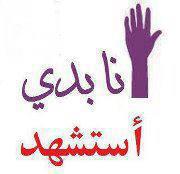
[`I Want to be Martyred" Uncredited Image from Facebook]
“I want to be martyred,” says one of the user-manipulated raised-hand, expressing the position of those who are willing to die for Syria. Another user-generated poster, featuring two hands that are about to shake each other, declares: “whether anti or pro-regime, you are still my brother and we care for the country,” evoking a middle ground proposal as a solution to the crisis.
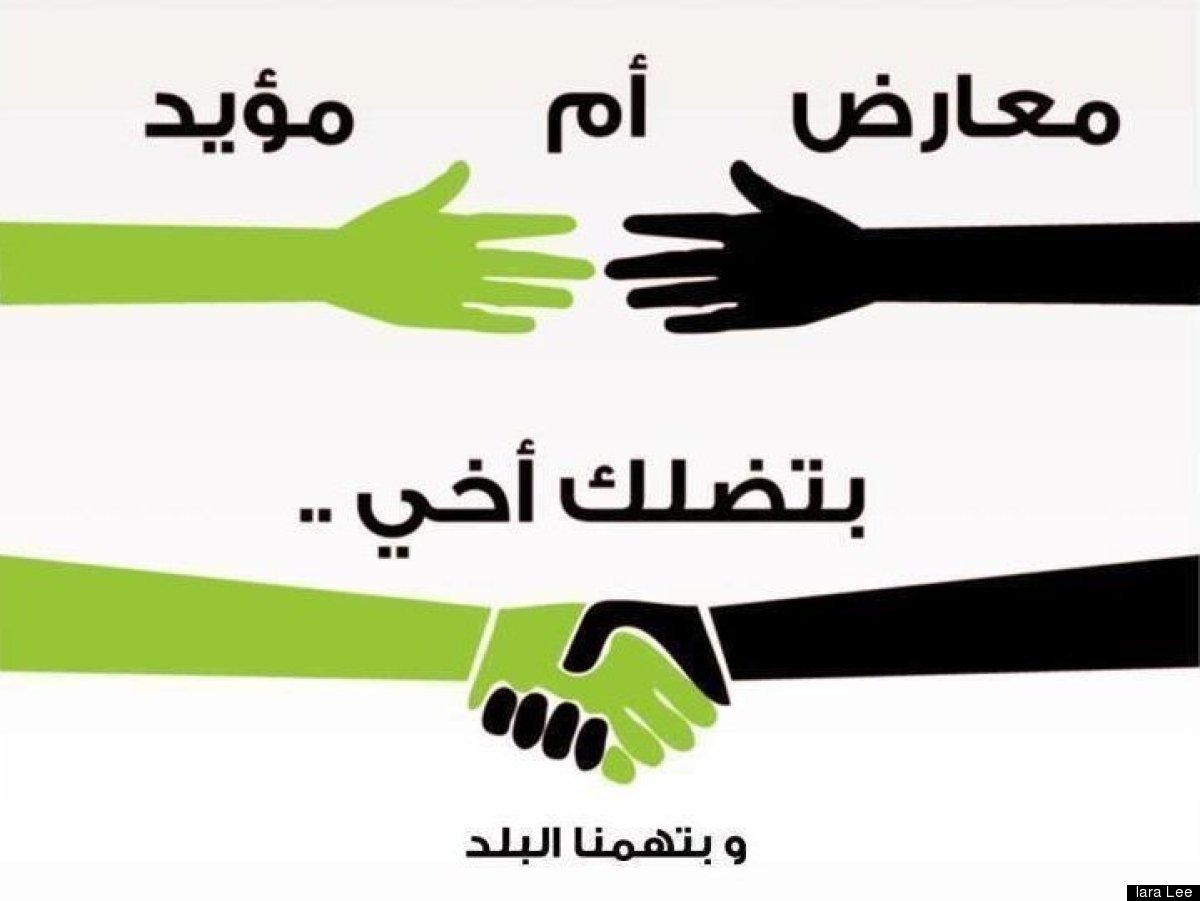
[“Whether Anti or Pro-Regime, You Are Still My Brother.." Uncredited Image from Facebook]
Also extreme pro-regime positions are featured within the user-generated “raised hands” counter-campaign; a poster with Bashar al Asad`s picture stating: “whether you like it or not, I love him.”
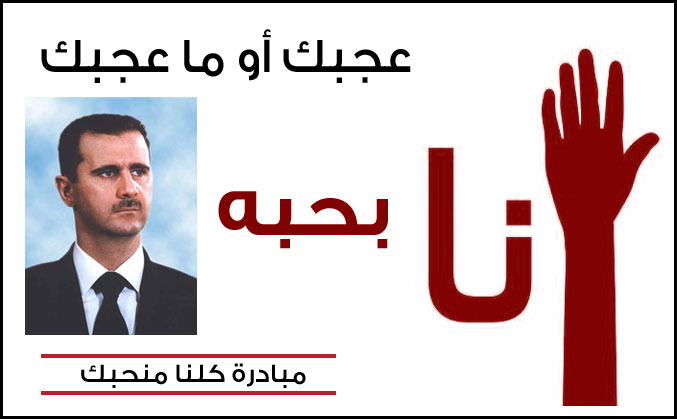
["Whether you like it or not, I love him." Uncredited Image from Facebook]
Finally, the raised-hand user-generated campaign is revelatory of people’s connections that are not built through shared unbelief anymore; but, rather, thanks to a shared awareness of their ability to create, re-create and actively contribute to an open-ended citizenry`s forum. Here citizens match with peer-creators, and peer-creators with citizens, both engaged in “creating life” more than non-living artistic objects.
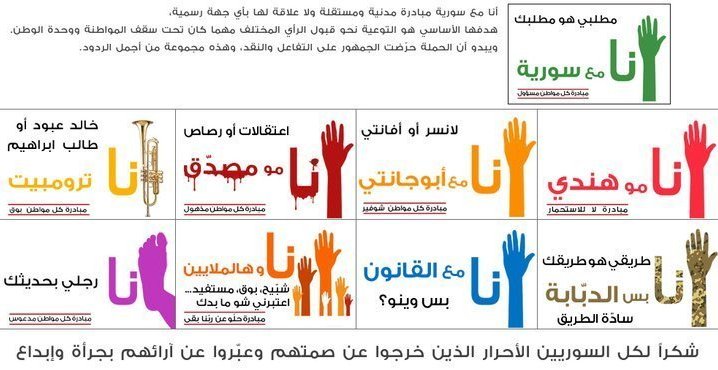
[Collage of remixed versions of the original posters. Some are satirical, others are ironic.
For instance one reads "My was is your way but the tank is in the way" and another
"I am with the law, but where is it?" Image courtesy of Ammar Alani]
-----------------------------------------
Footnotes
[1] Clay Shirky (2010) Cognitive surplus: creativity and generosity in a connected age. Penguin Press.
[2] Joichi Ito (1997) Aesthetics of the Internet – Context as a medium, paper for Ars Electronica Festival
[3] Francis Heylighen (1996) Evolution of memes on the Network: from chain-letters to the global brain, paper for Ars Electronica Festival.
[4] Joichi Ito (1997) quoted above.
[5] Charles Tilly (1991) Domination, resistance, compliance...discourse, Sociological Forum, vol 6, n 3
[6] Lawrence Lessig (2008) Remix: making art and commerce thrive in the hybrid economy, Penguin Press.
[7] Clay Shirky (2010) quoted above.
[8] Lawrence Lessig (2008), quoted above.
[9] Joichi Ito (1997) quoted above.
[10] See Donatella Della Ratta (2012) Dramas of the authoritarian state, Middle East Report online, February
[11] miriam cooke, 2007) Dissident Syria. Making oppositional arts official, Duke University Press, Durhan & London
[12] Lisa Weeden (1999) Ambiguities of Domination: Politics, Rhetoric, and Symbols in Contemporary Syria, The University of Chicago Press, Chicago.
[13] Lisa Wedeen (1999) quoted above
[14] Lisa Wedeen (1999) quoted above
[15] Lisa Weeden (1999) quoted above
[16] “Communities, multi-user games systems, markets, search engines and router configurations are all context oriented. The aesthetic of context is the design of such context-oriented systems which are outstanding in their nature. A good context-oriented system causes the network of living connections to converge, interact and grow. It adds value to the network and attracts users and connections.
[17]Joichi Ito (1997) quoted above.
[18] Joichi Ito (1997) quoted above.
[19] Joichi Ito (1997) quoted above.